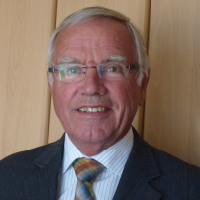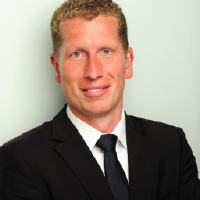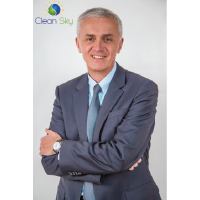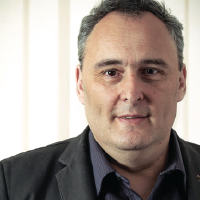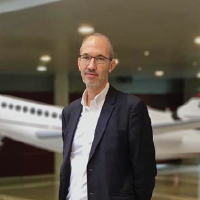Mr. Yann Barbaux is Senior Vice President at Airbus and Executive Chairman of Aerospace Valley.
No need to say that the world is facing an unprecedented crisis, both sanitary and economic crisis, which impacts the civil aeronautics industry very severely and for a duration that nobody can seriously predict today. And the impact is even more severe because the crisis happened during a phase of incredible ramp-up, also never encountered before. In the past we were used to say that aeronautics was a cyclic sector… but over the last 20 years our industry did not experience any down-turn: the sanitary crisis in 2002-2003, or the financial crisis in 2008 only resulted in a slow-down of the ramp-up, limited in time. In March – April, at the first peak of the pandemic, air traffic went down to 10-15% of what it was previously. If the situation has improved air transport is, in fact, far from overcoming the crisis. About 73% of medium-haul single-aisle and 59% of long-haul wide-body have returned to service, but their utilization and occupancy rates remain 25% below normal. The situation is also much contrasted from one region to another. If China has regained 90% of its domestic air traffic, Europe is still only 60%, North America at 55%, South America at 44%, the Middle East at 35 % and Africa at 27%. The most striking contrast, however, is between domestic traffic, which has fallen to 49%, and international traffic, still only 12% at the end of August, due to the restrictions imposed at the borders. The only ones to do well are cargo planes, used at 100% of their capacity and whose traffic has increased by 11% since the start of the year. And the 2nd wave of the pandemic just pushes these figures down again, even if the perspective of a vaccine being available beginning of 2021 makes the community optimistic.
This situation led both Airbus and Boeing to reduce their production rate. However, both manufacturers still forecast a virtual doubling of the world fleet over the next 20 years. At the current rate of production, reduced by 40% in April, Airbus should indeed deliver more than 500 devices per year (against 863 in 2019). And Boeing should do almost the same, in particular by disposing of some 450 Max accumulated since March 2019. So much so that in total, deliveries of civil aircraft from the two main aircraft manufacturers would remain at around a thousand aircraft. per year, i.e. the level of 2011, instead of the 1,600 deliveries reached in 2018, before the B737 Max crisis.
In parallel our civil aviation industry is facing numerous severe attacks from NGOs because of its impact on environment. We all know that air transportation is responsible for only 2 to 3 percent of Greenhouse Gas Emissions originating from human activity, to be compared with 6 to 9% for Internet or 15% for animal farming, but it is very symbolic and seen as not absolutely necessary… This is driving us to accelerate as much as we can our ecological transition towards neutral growth, targeting to reach the already very ambitious goals of Flightpath 2050 much earlier. So we must take the opportunity of the crisis to accelerate the development of much cleaner aircraft.
Q1: The immediate impact of the crisis is a severe economic downturn of the whole industry, starting with airlines postponing or stopping orders and deliveries, creating a snowball effect on the complete value chain, with a drastic lack of cash to finance projects. In a first step many on-going projects were put on-hold or cancelled.
Fortunately, at least in Europe, many countries took measures to limit this impact (long term furlough covered by state aids in particular). In parallel, the ramp-down made human resources available and some governments put in place specific financing schemes to support innovation, in priority to support the move towards a more sustainable aviation. But this is not supported by some / several politicians, due to the pressure from NGOs mentioned before.
The development of new generation aircraft is a wonderful opportunity for the complete value chain: our industry needs better batteries, more effective electric engines, smarter energy management systems, efficient and environmentally friendly solution to produce and store hydrogen, but also, because we should not forget that we are flying heavier than air, new lighter and stronger materials and associated manufacturing…
In parallel the development of these new technologies also results in the possibility of imagining new products for new usage, so called new mobility: drones, obviously, in support to lots of missions from surveillance of infrastructures to the last mile delivery, but also new segments for civil aviation: I’m particularly thinking of the development of aircraft up to 19 seats for very short haul flights, typically 400 km. The move to electric propulsion, already possible for this type of aircraft and mission from a technical view point, makes it also economically viable. As a matter of fact electric propulsion also results in a very important reduction in maintenance costs. The development of these new segments will give a second life to small airports, which will even have a positive side effect, as no additional infrastructure will be needed.
Q2: The risk when we are in a situation like the one we face today - and we see it in the way the sanitary measures are taken - is that every country tries to find solutions at its level, and even sees the crisis as an opportunity to better position some of its champions. But we know that our industry finds its roots in a very effective and long lasting cooperation at European level. So…
1. It’s absolutely necessary to have a strong European approach: The challenge to reach a real carbon free aircraft is huge: technically obviously, but also with regard to what it means in terms of changes in infrastructures, starting with Airports, and in terms of supply chain. Whether we consider electric flight or hydrogen we all know that this cannot happen if it’s supported only by the aviation sector, which is important for sure, but represents small sales numbers for most suppliers. So…
2. We need a coordinated approach with other industrial sectors to develop rapidly the critical technologies: As stated before, due to the crisis, most of the actors are missing cash, and for the smallest ones have huge debts: so…
3. Europe must push for allocating more money to a very ambitious European R&T program on carbon-free aviation but also...
4. The European Commission needs to consider different financing schemes, in particular for SMEs, with a larger proportion of public co-funding: Why not up to 100% for very risky research with long term perspective of market. This higher public co-funding might be (if absolutely required) counter-balanced by the fact that the European Union would own the IP developed on projects, until industries have the possibility to buy it back when the market is there.
Last point, because our sector is facing severe attacks from NGOs, which are not fair considering the real ecological impact of aviation, and because:
• The aerospace sector is a major contributor to the creation of wealth and jobs in Europe,
• It’s an accelerator for the development of technologies which improve the life of citizens,
• It’s an important tool for facilitating exchanges between people across the world, contributing to a better mutual understanding which helps for leaving in peace.
5. We need to have a strong and authentic support from politics.





